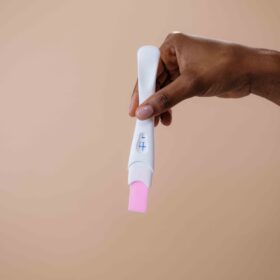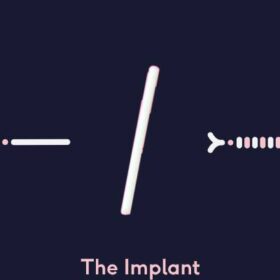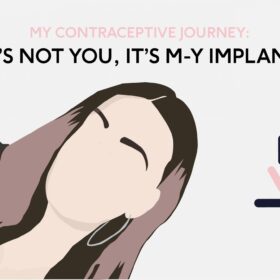
The contraceptive implant: common side effects and reviews
There are so many types of contraceptives it can be hard to know which one is best for you. Experiences differ from person to person and it’s always good to read real user experiences.
In this post, we’re looking at the contraceptive implant and sharing our data on the most common side effects as experienced by over 6000 real people.
What is the birth control implant?
The contraceptive implant (Nexplanon) is a small soft flexible rod made out of ethylene vinyl acetate copolymer (plastic) that goes under your skin. It releases a hormone called progestogen that works to prevent pregnancy. It lasts for three years before it should be replaced.
How does the contraceptive implant work?
Once placed under the skin of your upper arm by a doctor or nurse, it releases the hormone etonorgestrel, a type of progestogen, gradually into your bloodstream. This works to prevent pregnancy in three ways: by stopping ovulation, making the fluid in your cervix thicker (making it more difficult from sperm to enter the womb), and preventing the lining of your womb thickening enough for an embryo to grow in it.
How effective is the contraceptive implant?
It is 99% effective, meaning that the chances of getting pregnant on the implant are fewer than 1 out of 100 women over the course of a year.
What are the most common contraceptive implant side effects?
Lowdown users report the most common side effects of the implant (data taken September 2024):
- Mood changes 63%
- Tender breasts 51%
- Decrease in sex drive 50%
- Irregular bleeds 45%
- Period cramps 44%
- Vaginal discharge 41%
- Vaginal dryness 38%
- Headaches 15%
- Spotting 13%
- Spots or acne 4%
However these symptoms often settle after a few months.
Changes in your periods are common. These can include spotting or irregular bleeding, prolonged bleeding or your periods may stop altogether. Around 20% of women can expect to have no periods and 30% of women less than 1 period a month.
Because of how it works the implant could help to reduce period pain, pain related to ovulation and heavy periods. However, 9% of our users report experiencing heavy periods (data taken September 2024), which just shows how individual side effects are.
Women have also reported other possible side effects but the lack of research into this area means we don’t have scientific evidence that links these to the implant. For example there is no scientific evidence that the implant causes weight gain. As of September 2024, 41% of Lowdown users reported putting on weight while using the implant, but this is thought to be due to natural weight gain as part of ageing that would happen normally without contraception. A similar number of users (38%) had no change to their weight.
Check out some of our user’s contraceptive implant reviews:
“Excellent for the first 3 years, not having to think about it at all was the biggest selling point to me, but now after almost 6 years – with acne, weight gain and mood swings I’m wondering if it’s time to try something else.” – Lowdown user, October 2020
“I really like the implant. Basically having no periods is great and cheap! Haven’t noticed any negative side effects. Getting it put in was easy, having it changed was a bit weird but fine. A tiny bit annoying there is 2 small scars on my arm now.” – Lowdown user, on her second implant
“After a year and a half of the implant, I’m getting recurrent thrush and my moods are frequently low. Periods finally started again but were very heavy and irregular. Sex drive is totally gone. Not fantastic but no acne and I got a year and a half without periods.” – Lowdown user, chose to remove the implant
Risks of the contraceptive implant
Implant insertion is very safe, but there are some side effects and risks to be aware of. The common ones are pain (occuring in 1 in 20 insertions) and bruising or bleeding (1 in 50 insertions). The bruising can be mild, or quite large.
However, there are a few rare risks to keep in mind. One is implant migration – sometimes the implant can shift slightly, usually by about 2cm. In very rare cases, implants have moved to other areas like the armpit or the shoulder. Extremely rarely, it can even migrate to the veins in the lungs, happening in just 1 out of every 1.3 million implants. Nerve or muscle damage from the insertion is considered a theoretical risk, but there’s no strong evidence or research showing how often this happens.
Removal of the contraceptive implant
To remove the contraceptive implant you will need to go back to your heathcare provider – DO NOT attempt to take it out yourself.
The procedure is normally fairly simple and should only take a few minutes. As soon as it’s removed you won’t be protected from pregnancy. You will have a local anaesthetic injection, then the doctor or nurse will make a tiny cut in your skin and gently pull the implant out. They will put a dressing on the arm to keep it clean and dry and reduce any bruising. You can then have a new one replaced if you want to continue with the method.
Check out some of our reviews regarding the contraceptive implant removal:
“My first implant insertion went well and better than expected. However, I went to have it renewed and they had to remove, create a new incision and insert into a new area. My arm looks awful and is very bruised. I expected a little but not as much as this. I won’t be getting this inserted again as the procedure is a little much for me. Although I will say as a contraceptive it has been effective and any side effects have been bearable.” – Lowdown user, loves the implant, not the procedure
Our medical review process
This article has been medically reviewed for factual and up to date information by a Lowdown doctor.






